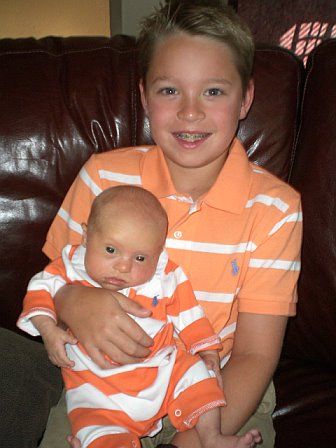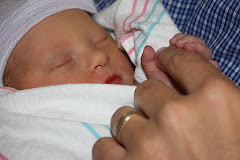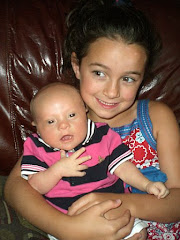this article was in the NY Times.com, this is what we fight for, problem is, within our own community we have a "divided house." People that believe that with medication we are "changing" our kids. Here is the thing, we straighten our kids teeth with braces, we fix their heart conditions, we repair broken bones, we treat diabetes, we take allergy medications for allergies, don't we want the best for our kids and ourselves? Take the time to read and comment, with new non-invasive testing becoming available as soon as the next year potentially. This research field for DS may dry up because kids like Parker will have an even smaller chance of being born. Leaving my precious son and others without the chance of living improved, independent lives.
Thanks Dr. Costa and others for you dedication and continued pursuit!
"July 29, 2011
A Drug for Down SyndromeBy DAN HURLEY
Correction Appended
Early in the evening of June 25, 1995, hours after the birth of his first and only child, the course of Dr. Alberto Costa’s life and work took an abrupt turn. Still recovering from a traumatic delivery that required an emergency Caesarean section, Costa’s wife, Daisy, lay in bed, groggy from sedation. Into their dimly lighted room at Methodist Hospital in Houston walked the clinical geneticist. He took Costa aside to deliver some unfortunate news. The baby girl, he said, appeared to have Down syndrome, the most common genetic cause of cognitive disabilities, or what used to be called “mental retardation.”
Costa, himself a physician and neuroscientist, had only a basic knowledge of Down syndrome. Yet there in the hospital room, he debated the diagnosis with the geneticist. The baby’s heart did not have any of the defects often associated with Down syndrome, he argued, and her head circumference was normal. She just didn’t look like a typical Down syndrome baby. And after all, it would take a couple weeks before a definitive examination would show whether she had been born with three copies of all or most of the genes on the 21st chromosome, instead of the usual two.
Costa had dreamed that a child of his might grow up to become a mathematician. He had even prevailed upon Daisy to name their daughter Tyche, after the Greek goddess of fortune or chance, and in honor of the Renaissance astronomer Tycho Brahe. Now he asked the geneticist what the chances were that Tyche (pronounced Tishy) really had Down syndrome.
“In my experience,” he said, “close to a hundred percent.”
Costa and his wife had been trying to have a baby for a couple of years. Daisy’s first pregnancy ended in a miscarriage, which they knew can occur because of a genetic disorder in the fetus. When Daisy became pregnant a second time, Costa insisted they get a chorionic villus sampling, an invasive prenatal genetic test. But the procedure caused a miscarriage. (The test showed that the fetus was genetically normal.) Costa vowed that if there was a third pregnancy — this one — they would conduct no prenatal tests.
Now, with Tyche bundled peacefully in a bassinet at the foot of Daisy’s bed, and Daisy asleep, Costa sat up through most of the night crying. He had gone into the research side of medicine in part to avoid scenes like this — parents devastated by a diagnosis. But by morning, he found himself doing what any father of a newborn might: hovering by the crib, holding his daughter’s hand and marveling at her beauty.
“From that day, we bonded immediately,” he told me during one of our many talks over the last year. “All I could think is, She’s my baby, she’s a lovely girl and what can I do to help her? Obviously I was a physician and a neuroscientist who studies the brain. Here was this new life in front of me and holding my finger and looking straight in my eyes. How could I not think in terms of helping that kid?”
With no experience in the study of Down syndrome, Costa took a short walk the next day to a library affiliated with Baylor College of Medicine, where he worked as a research associate in neuroscience. Reading the latest studies, he learned that the prognosis was not nearly as dire as it was once considered. Life expectancies had grown, education reforms had produced marked gains in functioning and — of particular interest to Costa — a mouse model of the disorder had recently been developed, opening the door to experimentation. He soon made a decision: he would devote himself to the study of Down syndrome.
In 2006, using mice with the equivalent of Down syndrome, Costa published one of the first studies ever to show that a drug could normalize the growth and survival of new brain cells in the hippocampus, a structure deep within the brain that is essential for memory and spatial navigation. In people with Down syndrome, the slower pace of neuron growth in the hippocampus is suspected to play a key role in cognitive deficits. Follow-up studies by other researchers reached conflicting results as to whether the drug Costa had tested, the antidepressant Prozac, could produce practical gains on learning tests to match its ability to boost brain-cell growth. Undeterred, Costa moved on to another treatment strategy. In 2007 he published a study that showed that giving mice with Down syndrome the Alzheimer’s drug memantine could improve their memory.
Now Costa has taken the next step: he is completing the first randomized clinical trial ever to take a drug that worked in mice with Down and apply it to humans with the disease, a milestone in the history of Down-syndrome research.
“This was a disorder for which it was believed there was no hope, no treatment, and people thought, Why waste your time?” says Craig C. Garner, a professor of psychiatry and behavioral sciences and co-director of the Center for Research and Treatment of Down Syndrome at Stanford University. “The last 10 years have seen a revolution in neuroscience, so that we now realize that the brain is amazingly plastic, very flexible, and systems can be repaired.”
But the effects of that revolution on Down research may yet be cut short. A competing set of scientists are on the cusp of achieving an entirely different kind of medical response to Down syndrome: rather than treat it, they promise to prevent it. They have developed noninvasive, prenatal blood tests which would allow for routine testing for Down syndrome in the first trimester of a pregnancy, raising the specter that many more parents would terminate an affected pregnancy. Some predict that one of the new tests could be available to the public within the year.
Costa, like others working on drug treatments, fears that the imminent approval of those tests might undercut support for treatment research, and even raises the possibility that children like Tyche will be among the last of a generation to be born with Down syndrome.
“It’s like we’re in a race against the people who are promoting those early screening methods,” Costa, who is 48, told me. “These tests are going to be quite accessible. At that point, one would expect a precipitous drop in the rate of birth of children with Down syndrome. If we’re not quick enough to offer alternatives, this field might collapse.”
So recently was the genetic cause of Down syndrome established that just this past March, Costa actually met the widow of the French scientist, Jérôme Lejeune, who made the discovery in 1959. The scene of their meeting was a Paris conference, named in honor of Lejeune, where neuroscientists from around the world discussed progress into treatments for Down and related diseases. Such a conference would have been inconceivable when Costa entered the field 15 years ago.
“If you think about most genetic diseases, they’re usually caused by one gene, and in fact one mutation at one amino acid,” says Roger Reeves, a professor at the Institute for Genetic Medicine at the Johns Hopkins University School of Medicine. “But with Down syndrome, you have an extra copy of all 500 or so genes on Chromosome 21.” In the first two decades after Lejeune’s discovery, the very idea of grappling with those hundreds of triplicated genes scared off scientists from any serious effort to find a treatment for what they were soon calling “trisomy 21.” It just seemed impossibly complex. “The turning point,” Reeves says, “came when Muriel Davisson made her mouse.”
Davisson, now semiretired from Jackson Laboratory in Bar Harbor, Me., spent the 1980s developing a mouse, known as Ts65Dn, that had many of the traits associated with Down syndrome, including, incredibly, the distinctive facial characteristics associated with the disease and the same slightly uncoordinated gait.
Five years after publishing news of her mouse, Davisson received an e-mail from a young neuroscientist named Alberto Costa. Her work, he told her, opened the door for him to conduct meaningful new drug research.
“It was an epiphany, that, oh, this is a field where I can apply a lot that I’ve learned,” Costa says. “Science is usually unforgiving with people who try to change career paths, but it was a risk I was willing to take.” Having earned his Ph.D. studying the electrical and chemical basis of communication between brain cells, “I figured, O.K., if there is something that can be done in this field, it’s going to be done at that level of neuronal electrophysiology.” After months of reading the latest studies, Costa knew he needed Davisson’s mice.
“He twisted my arm till I took him into my lab,” Davisson says with a laugh. “I didn’t have funding. He wrote a grant to get the funding. He is very enthusiastic.” She also found out that he was a “perfectionist, and not very tolerant of people who aren’t perfectionists. He doesn’t do experiments without being sure he’s doing them right. When he makes a finding, you know that it’s real.”
Using Davisson’s mice, Costa’s 2006 study with Prozac produced cellular changes in the brain. In 2007, Craig Garner at Stanford took the next step, reporting behavioral improvements in Ts65Dn mice after weeks of drug treatment. (Earlier this year, a company he co-founded to pursue that strategy received funding from a venture-capital firm.) Four months later, Costa published his memantine study, showing that a single injection of the drug produced behavioral benefits within minutes, enabling Down-equivalent mice to learn as well as standard mice.
Memantine works, Costa hypothesizes, not by boosting the growth of brain cells but by normalizing how existing cells use the neurotransmitter glutamate. Because people with Down syndrome have three copies of all or most of the genes on Chromosome 21 instead of just two, they have about 50 percent more of any proteins encoded in that chromosome. One result, Costa has shown, is that the NMDA receptors of Ts65Dn mice are “hyperactive” — they overreact to stimuli. By responding to too many things, they learn too little; the signal is lost amid the noise. But giving memantine to quiet the noisy NMDA receptors, Costa has found, makes the brain cells react almost normally.
Other drugs that work on different systems in the brain have also shown benefits in the Ts65Dn mouse. In 2009, Dr. William C. Mobley, chairman of neurosciences at the University of California, San Diego, and one of the most active and visible researchers in the field, co-wrote a study showing that a combination of drugs designed to raise norepinephrine levels in the brain normalized the mice’s learning abilities. Most recently, last year the Nobel laureate Paul Greengard of Rockefeller University showed that memory and learning could be normalized in Ts65Dn mice by lowering levels of beta amyloid, the protein goop that has long been known to clog the brains of people with Alzheimer’s disease.
“There’s been a sea change in our ability to understand and treat Down syndrome,” Mobley says. “There’s just been an explosion of information. As recently as the year 2000, no drug company would possibly have thought about developing therapies for Down syndrome. I am now in contact with no less than four companies that are pursuing treatments.”
Costa’s current memantine study began by testing memory and spatial learning in 40 young adults with Down syndrome. Daily, for 16 weeks, half received memantine pills, the other half a placebo. This fall, Costa will present preliminary results at a scientific meeting in Illinois on whether taking the drug made those with Down, in a word, smarter.
A half-hour from his office and laboratory at the University of Colorado-Denver School of Medicine, where he is an associate professor of medicine and neuroscience, Costa pulled into a parking space in front of his modest two-bedroom apartment. The figure of a girl in green dashed toward the car — and then vanished.
“Tyche,” Costa called to his daughter, “where’d you go?”
We both stepped out to look for her. I found her standing in front of another car, a Subaru Forester, waiting to get in. Dressed in a lime-colored shirt and skirt, the bangs of her mahogany hair framed by a hair band, Tyche stood just 4 feet 6 inches tall, with a round face, broad nose and heavy-lidded eyes.
Seeing my puzzled look, Costa explained that they also owned the Subaru — which he usually drove with Tyche. He led her to the Toyota we’d arrived in, where she sat down in the back seat. As Costa drove us to his office, I asked what she thought of her father’s work.
“He’s the greatest scientist,” she said, in a slurred, high-pitched voice. Then she added with a laugh, “And he builds evil machines.”
“That’s from watching too many cartoons,” Costa said. “Her favorite is ‘Phineas and Ferb.’ Of course, there’s an evil scientist in it who builds all kinds of machines.”
“Like the Smell-inator,” added Tyche, who turned 16 in June.
Back at Costa’s office, Tyche demonstrated to me what people with Down can be capable of even without medication. (Because she’s not an adult, Tyche is ineligible to participate in her father’s study.) On the whiteboard at the front of the room, Costa wrote out an algebra problem for her to solve: 8x2 - 7 = 505.
“She’s one of only two people with Down syndrome who I’ve ever known to be capable of doing algebra,” Costa said. “Normally we give her a problem before she goes to bed.” As she solved the equation, taking six steps to conclude that X equals 8, he said, “It’s basically instead of a bedtime story.” This past Christmas, he proudly noted, he gave her the Rosetta Stone language program for learning Portuguese, and by March she had finished with Level 1 and begun Level 2.
It turns out that with vigorous education and support, many people with Down do far better than once thought possible. Medical care of heart and other physical ailments associated with the disorder have likewise achieved significant benefits, doubling the average lifespan from 25 to 49, in just the 14 years between 1983 and 1997.
Still, with an I.Q. that is typically around 50 points lower than average — with some far lower and others, like Tyche, reaching higher — something more than education alone would be necessary to enable the majority of people with Down syndrome to live independently. Costa said he hopes that memantine might be that something, raising I.Q. noticeably, even if modestly. For him, the goal is to help people with Down syndrome achieve autonomy. “At some point, you want your children to have their own life,” he said. “It’s about independence.”
Costa was raised in Brazil, the son of a marine officer and a seamstress. When he was 14, his parents divorced. His father sent little support, and he and his two siblings lived with their mother in poverty. Perhaps inevitably for someone who had to struggle to rise above his circumstances, he comes across as intense and consumed by his work; he hasn’t taken a vacation since Tyche was 3. But he is also devoted to his daughter and wife, spending most of every weekend with them.
“She’s a great kid,” he said. “She has a very strong personality. In many ways she has features of a regular teenager. She doesn’t like me to get into her bedroom. She loves pop music and vampires.” Her relatively high functioning, he told me, is important to him. “If Tyche were really severely affected, I don’t know if I would have had the energy to go on with this business.” Then again, he admits to having paternal feelings toward all 40 young adults in his study, whose cognitive abilities vary widely. “At the end of the day,” he said, “their parents know someone really cares for their kid. It’s not an academic experience for me. It’s my life.”
In January, and again in March, a spate of news reports described new studies of the noninvasive blood tests that would allow pregnant women to check for Down syndrome without the risks and discomfort associated with chorionic villus sampling and amniocentesis. Few of the articles, however, took note of the profound unease many medical ethicists, including some who are ardently pro-choice, feel about the tests and how they might lead to a dramatic reduction in the Down syndrome population.
“Even people who are traditionally against abortion are sometimes willing to condone it when the abortion is of a fetus with a disabling trait,” says Erik Parens, a bioethicist at the Hastings Center in Garrison, N.Y. “But it’s important to recognize that there is a huge range of genetic disorders. In their own way, a lot of kids with Down syndrome flourish, and so do their families.”
Advocates of the new tests insist that parents will be given news of an affected pregnancy by a trained geneticist who will present the information fairly and fully. Critics, including Costa and many other parents of children with Down syndrome, say that such dispassionate approaches rarely happen in practice, with many obstetricians and genetic counselors providing unduly negative or misleading information.
But Stephen Quake, a professor of bioengineering and applied physics at Stanford and a developer of one of the new tests, says: “It’s a gross oversimplification to assume that these tests are going to lead to the wholesale elimination of Down-syndrome births. My wife’s cousin has Down syndrome. We just celebrated his 21st birthday. He’s a wonderful person. It’s not an obvious step that you would terminate an affected pregnancy.”
But Costa points to a falloff in the financing of Down-syndrome research since the prenatal tests have been in development. Although it’s difficult to compare the numbers, money from the National Institutes of Health dropped to $16 million in 2007 from $23 million in 2003, before creeping back up to $22 million in 2011. That’s far less than the $68 million slated for cystic fibrosis, which affects an estimated 30,000 people in the United States, at most one-tenth of the 300,000 to 400,000 people who have Down.
“The geneticists expect Down syndrome to disappear,” Costa says, “so why fund treatments?”
Alan Guttmacher, director of the National Institute of Child Health and Human Development, denies that this is the calculus used by his organization. Yet he offered no clear answer when I asked him why about $3,000 in research dollars is spent by N.I.H. for every person with cystic fibrosis, compared with less than $100 for every person with Down.
“The number affected is a fair metric to use,” Guttmacher said. But, he pointed out, most of N.I.H.’s funding decisions are based on the strength of proposals coming from researchers. Advocacy groups for disorders like AIDS, autism and breast cancer have certainly played a role in their gaining increased funding, he said. And perhaps, he speculated, Down suffers from an image problem. “Part of it is that Down syndrome has been around for so long,” he said.
Representative Cathy McMorris-Rodgers, Republican of Washington, who co-founded the Congressional Down Syndrome Caucus soon after her 4-year-old son, Cole, was born with the disorder, has had little success in having money appropriated for Down research.
“I find myself wondering how N.I.H. really sets their priorities,” she told me. “I’m quite concerned that so many of the researchers in the Down-syndrome field have difficulty getting funded.” She continued, “My fear is that for some, they believe that it’s been taken care of through prenatal diagnosis.”
Even Costa has struggled to secure financing. He lives with Tyche and Daisy in a rented apartment, having never felt he had enough job security to buy a home. At his laboratory, some of his most expensive and sophisticated equipment for studying Down syndrome remains in storage, literally gathering dust for want of financing to use it. One source of his research money has been the Anna and John J. Sie Foundation, based nearby in Denver, and run by Michelle Sie Whitten, whose 8-year-old daughter has Down syndrome. Three years ago, the foundation established a research institute at the University of Colorado in Denver, where Costa works.
Plainly, though, he didn’t get into Down-syndrome research for the money. “There’s a reason why I’m doing what I’m doing,” he told me, nodding toward Tyche.
Not all parents of children with Down syndrome embrace Costa’s vision of a medical treatment targeting intelligence. In a recent survey conducted in Canada, parents were asked what they would do if there was a “cure” for their child’s Down syndrome. A surprising 27 percent said they would definitely not use it, and another 32 percent said they were unsure.
Meanwhile, the major not-for-profit advocacy groups devoted to Down syndrome spend little on research, instead preferring to lobby and offer parental support. Fresh energy has come from two relatively new groups determined to turn the situation around — Research Down Syndrome and the Down Syndrome Research and Treatment Foundation — but even they have so far succeeded in each raising only about $1 million a year, a fraction of the annual research budgets of many other disease-advocacy groups.
Behind the ambivalence toward treatments, some parents say, is a fear that increasing their children’s intelligence might change their personalities — their very identities.
“Nobody would be against giving insulin for diabetes,” said Michael Bérubé, director of the Institute for the Arts and Humanities at Pennsylvania State University and author of the 1996 book “Life as We Know It,” published five years after his second son, Jamie, was born with the disorder. “But Down syndrome isn’t diabetes or smallpox or cholera. It’s milder and more variable and more complicated. I’d be very leery of messing with the attributes Jamie has. He’s pretty fabulous. At the same time, I’m not doctrinaire. If you’re talking about a medication that allows people to function in society and hold jobs, how can you be against that?”
The parents I met whose children participated in Costa’s study expressed little of Bérubé’s ambivalence. Peggy Hinkle told me about changes she saw in her 26-year-old daughter. “When Christina was on the pills, she told me one morning about a dream she had. She gave me five full, complete sentences. Which is a very big deal. Not only that, she left the room and came back later and told me another sentence about the dream. And she started to do Jumble word puzzles in the newspaper. I don’t know if she was on the drug or on placebo, but after five weeks there was a change. Boom. That’s why we participated: to expand her horizons.”
For his part, Costa has no doubts about the work to which he has devoted the last 15 years of his life. “If you have a disorder that’s changing the function of an organ, which in this case is the brain, and you use a medication to bring the function of that organ closer to where it was meant to be from millions of years of evolution, that’s as fair as treating any other disease,” he said. “I don’t see it as any different.” If his current study is successful, Costa’s ultimate goal is to test it in youths, like Tyche, during the crucial early years of development. Costa is quick to point out that he has not offered her memantine outside the study, and he discourages other physicians from doing so until its safety and effectiveness is proved. But from his perspective as both a researcher and a father, he said: “The sooner you start, obviously, the greater would be your hopes. All I know is, the clock is ticking.”
Dan Hurley (hurleydan1@gmail.com) is the author of "Diabetes Rising: How a Rare Disease Became a Modern Pandemic, and What to Do About It."
Editor: Ilena Silverman (i.silverman-MagGroup@nytimes.com)
Correction: July 30, 2011
An article on Page 28 this weekend about Dr. Alberto Costa’s search for a drug that could help Down syndrome patients misidentifies a neurotransmitter that Dr. Costa says is affected by the drug memantine. It is glutamate, not NMDA. The article also misstates, in one instance, Dr. Costa’s surname as Castro.
Saturday, July 30, 2011
Wednesday, July 20, 2011
One Year Ago Today..




at this time last year we had handed our precious baby boy over to the surgeon at TCH for heart surgery. We were huddled as a family in the family center at TCH. The support of family and friends in that room was apparent and I am truly grateful. I must admit somedays it seems like years ago, other days it is hard to believe a year has past. Parker has accomplished so much in the last year, he is a different boy than he was last year. He's walking (running), talking, and getting into all kinds of typical 2 yr old trouble. I don't reflect often on the surgery aside from touching his scar and praising God for His goodness. I don't let my mind wander when I hear about families that were not as blessed as we were during surgery. I don't spend time dwelling on "what if he needs another surgery" after talking to other friends who find out their kids need more OHS later in life unexpectedly either. A dear friend is in the hospital in critical care ICU faced with the possibility of a heart transplant so this last week I have thought of Parker's surgery more than usual. Her arrival to the hospital was totally unexpected, the result of a massive heart attack. It reminds me that none of our days are promised, God is the only one that knows what lies ahead. He expects us to remember that this is not our home, that our home is in heaven and we should not measure by the world's standards. I must admit our summer has been busier than ever and many days I find myself forgetting just this. Today, please join me in celebrating God's goodness, His favor on our family, and our precious son Parker who gives us such great joy!! To God be the glory!
Phillipians 1:9
"And this is my prayer; that your love may abound more and more in knowledge and depth of insight, so that you may be able to discern what is best and may be pure and blameless until the day of Christ, filled with the fruit of righteousness that comes through Jesus Christ - to the glory and praise of God."
Friday, July 1, 2011
Summer!








We continue to live life in the "fast lane," summer is supposed to be for lazy days...not so much around our house, we have been busier than ever! Thought I'd post some of the events over the last few weeks. Most of you remember we spend the summers playing baseball, last year the boys went all the way to State. Last night we won the first stage, District! Madeline has been busy with gymnastics, swimming, and theater. She was Miss Hannigan in Annie and earned herself a role as a Munchkin in the big production in the Wizard of Oz coming up in August. She loves to sing and she may have found a new passion! Mallory has been busy with gymnastics, swimming and girl scout camp. She is looking forward to her first sleep away camp with church in a few weeks. Both girls went to Vacation Bible School too. Parker and I have been busy with the typical therapy and Drs appointments, we just came back from Chicago Monday night after seeing his endocrinologist. Good news, Dr was pleased with impressed with his "skills" couldn't believe how well he was getting around (and getting into everything) and his verbal skills. He got bonus points for growing 1 1/4 inches since January and gaining a pound. He's now 32 1/4 inches and 23 lbs. We did a 4 hour growth hormone test and will have the results in about 10 days. We head back to Dallas on the 13th for his neurodevelopmental eval. Putting lots of miles on my car these days! Strangely this busyness feels like we are back to "normal" life. Days come when it seems overwhelming (and I'm still threatening to move to the country), but we have a great full life and we are blessed!
Can you tell who loves baseball? he's got quite the throwing arm too!
Subscribe to:
Posts (Atom)




















